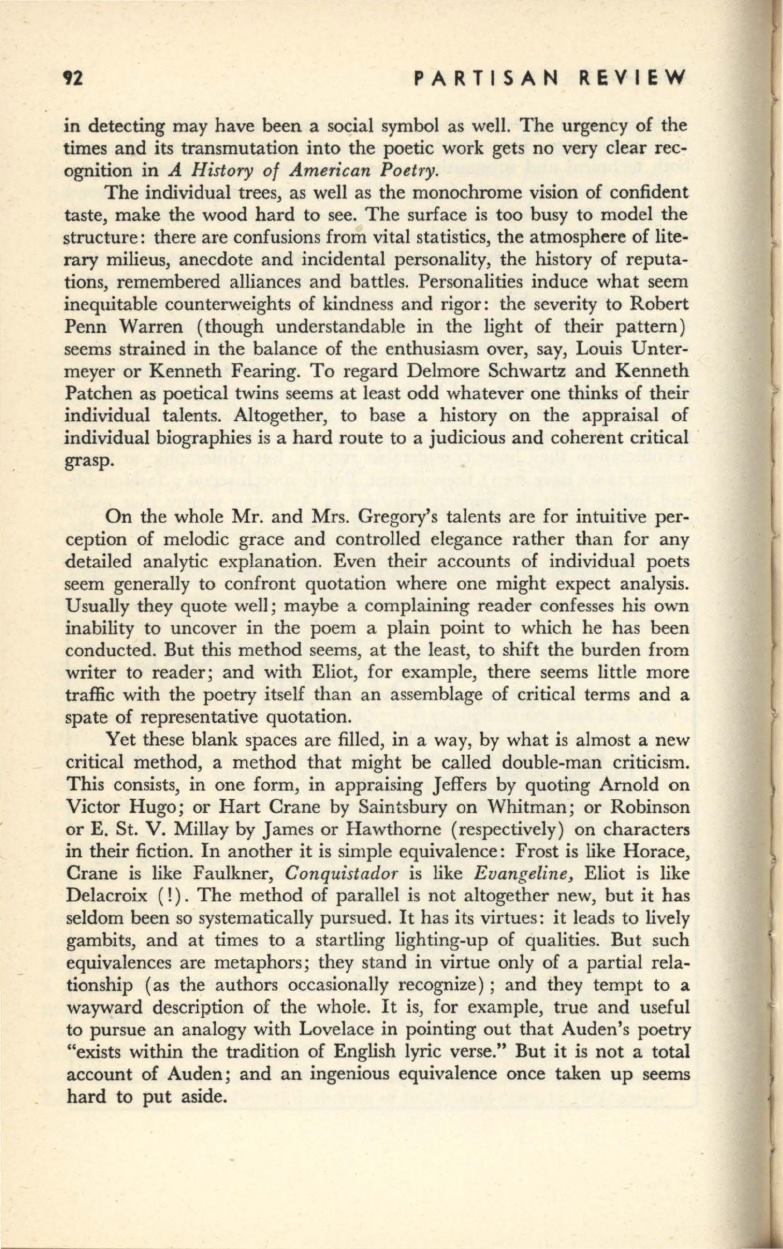
92
PARTISAN REVIEW
in detecting may have been a social symbol as well. The urgency of the
times and its transmutation into the poetic work gets no very clear rec–
ognition in
A History of American Poetry.
The individual trees, as well as the monochrome vision of confident
taste, make the wood hard to see. The surface is too busy to model the
structure: there are confusions from vital statistics, the atmosphere of lite–
rary milieus, anecdote and incidental personality, the history of reputa–
tions, remembered alliances and battles. Personalities induce what seem
inequitable counterweights of kindness and rigor: the severity to Robert
Penn Warren (though understandable in the light of their pattern)
seems strained in the balance of the enthusiasm over, say, Louis Unter–
meyer or Kenneth Fearing. To regard Delmore Schwartz and Kenneth
Patchen as poetical twins seems at least odd whatever one thinks of their
individual talents. Altogether, to base a history on the appraisal of
individual biographies is a hard route to a judicious and coherent critical
grasp.
On the whole Mr. and Mrs. Gregory's talents are for intuitive per–
ception of melodic grace and controlled elegance rather than for any
detailed analytic explanation. Even their accounts of individual poets
seem generally to confront quotation where one might expect analysis.
Usually they quote well; maybe a complaining reader confesses his own
inability to uncover in the poem a plain point to which he has been
conducted. But this method seems, at the least, to shift the burden from
writer to reader; and with Eliot, for example, there seems little more
traffic with the poetry itself than an assemblage of critical terms and a
spate of representative quotation.
Yet these blank spaces are filled, in a way, by what is almost a new
critical method, a method that might be called double-man criticism.
This consists, in one form, in appraising Jeffers by quoting Arnold on
Victor Hugo; or Hart Crane by Saintsbury on Whitman; or Robinson
or E. St. V. Millay by James or Hawthorne (respectively) on characters
in their fiction. In another it is simple equivalence: Frost is like Horace,
Crane is like Faulkner,
Conquistador
is like
Evangeline,
Eliot is like
Delacroix
(!).
The method of parallel is not altogether new, but it has
seldom been so systematically pursued. It has its virtues: it leads to lively
gambits, and at times to a startling lighting-up of qualities. But such
equivalences are metaphors; they stand in virtue only of a partial rela–
tionship (as the authors occasionally recognize) ; and they tempt to a
wayward description of the whole. It is, for example, true and useful
to pursue an analogy with Lovelace in pointing out that Auden's poetry
"exists within the tradition of English lyric verse." But it is not a total
account of Auden; and an ingenious equivalence once taken up seems
hard to put aside.


